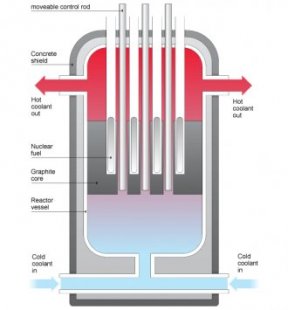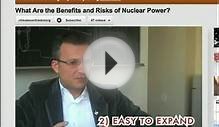
Nuclear power stations use the heat released by nuclear reactions to boil water to make steam
The type of nuclear reaction used is called nuclear fission. In nuclear fission:
- A neutron collides with a uranium nucleus. A uranium nucleus is large and unstable.
- The uranium nucleus splits into two similar-sized smaller nuclei.
- More neutrons are released.
- These neutrons can then collide with more uranium nuclei.
These processes are repeated continuously, forming a chain reaction A nuclear chain reaction occurs when a neutron splits a nucleus, releasing more neutrons, which in turn go on to split even more nuclei..
Rate of energy released
In a nuclear reactor, the reaction is controlled so that energy is released at a steady rate.
The energy released in nuclear fission is far greater than the energy released in a chemical reaction, such as burning fuel. This means that the power output of a nuclear power station is large. The lifetime of a nuclear power station is about 20 years.
Advantages and disadvantages
In considering the subject of nuclear power, it is important to weigh up the advantages and the disadvantages. These are some of the advantages:
- no carbon dioxide is produced when the station is operating, as stated earlier
- there is a high power output
- a small amount of fuel is needed, when compared with coal or gas
These are some of the disadvantages:
- hazardous radioactive waste is produced, as stated earlier
- building the power stations is quite expensive
- decommissioning, ie taking apart, the power stations at the end of their lifetime is very costly

Outline of a nuclear reactor
The nuclear fuel, usually uranium oxide, is held in metal containers called fuel rods. These are lowered into the reactor core. A coolant, usually water or carbon dioxide, is circulated through the reactor core to remove the heat. Control rods are also lowered into the core. These absorb neutrons and control the rate of the chain reaction. They are raised to speed it up, or lowered to slow it down.
YOU MIGHT ALSO LIKE












